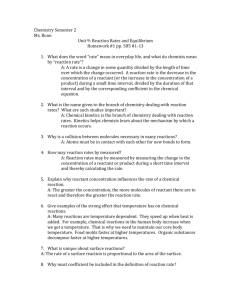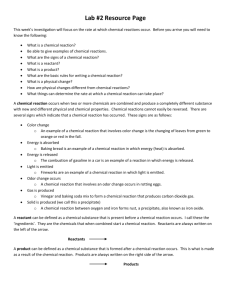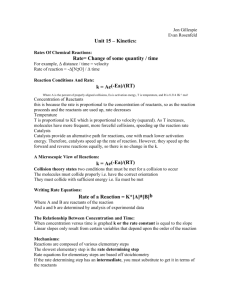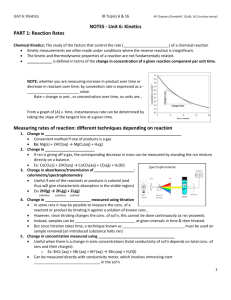MNHS Chapter 12 AP Chemistry Chemical Kinetics **Notes have
advertisement
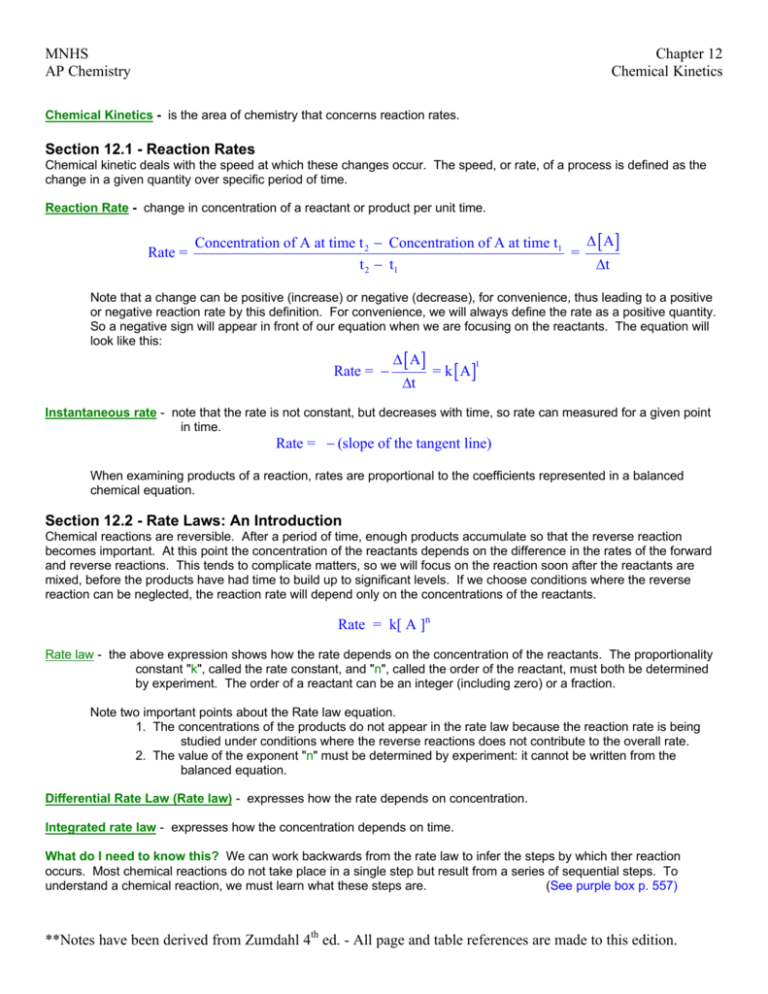
MNHS AP Chemistry Chapter 12 Chemical Kinetics Chemical Kinetics - is the area of chemistry that concerns reaction rates. Section 12.1 - Reaction Rates Chemical kinetic deals with the speed at which these changes occur. The speed, or rate, of a process is defined as the change in a given quantity over specific period of time. Reaction Rate - change in concentration of a reactant or product per unit time. Rate = ∆ [ A] Concentration of A at time t 2 − Concentration of A at time t1 = t 2 − t1 ∆t Note that a change can be positive (increase) or negative (decrease), for convenience, thus leading to a positive or negative reaction rate by this definition. For convenience, we will always define the rate as a positive quantity. So a negative sign will appear in front of our equation when we are focusing on the reactants. The equation will look like this: Rate = − ∆ [ A] ∆t = k [ A] 1 Instantaneous rate - note that the rate is not constant, but decreases with time, so rate can measured for a given point in time. Rate = − (slope of the tangent line) When examining products of a reaction, rates are proportional to the coefficients represented in a balanced chemical equation. Section 12.2 - Rate Laws: An Introduction Chemical reactions are reversible. After a period of time, enough products accumulate so that the reverse reaction becomes important. At this point the concentration of the reactants depends on the difference in the rates of the forward and reverse reactions. This tends to complicate matters, so we will focus on the reaction soon after the reactants are mixed, before the products have had time to build up to significant levels. If we choose conditions where the reverse reaction can be neglected, the reaction rate will depend only on the concentrations of the reactants. Rate = k[ A ]n Rate law - the above expression shows how the rate depends on the concentration of the reactants. The proportionality constant "k", called the rate constant, and "n", called the order of the reactant, must both be determined by experiment. The order of a reactant can be an integer (including zero) or a fraction. Note two important points about the Rate law equation. 1. The concentrations of the products do not appear in the rate law because the reaction rate is being studied under conditions where the reverse reactions does not contribute to the overall rate. 2. The value of the exponent "n" must be determined by experiment: it cannot be written from the balanced equation. Differential Rate Law (Rate law) - expresses how the rate depends on concentration. Integrated rate law - expresses how the concentration depends on time. What do I need to know this? We can work backwards from the rate law to infer the steps by which ther reaction occurs. Most chemical reactions do not take place in a single step but result from a series of sequential steps. To understand a chemical reaction, we must learn what these steps are. (See purple box p. 557) **Notes have been derived from Zumdahl 4th ed. - All page and table references are made to this edition. MNHS AP Chemistry Chapter 12 Chemical Kinetics 12.3 Determining the Form of the Rate Law The first step in understanding how a given chemical reaction occurs is to determine the form of the rate law. We need to determine experimentally the power to which each reactant concentration must be raised in the rate law. First order - doubling the concentration of "A" doubles the reaction rate. n=1 Rate = − ∆ [ A] ∆t = k [ A] 1 Method of Initial Rates - one common method for experimentally determining the form of the rate law for a reaction. Initial rate - of a reaction is the instantaneous rate determined just after the reaction begins (just after t = 0). Overall reaction order - sum of all the exponents in the rate law. Sample exercise 12.1 p.560 Section 12.4 - The Integrated Rate Law We will now include time into the rate law. First order rate laws - the rate of the reaction depends on the concentration to the first power, as seen earlier the equation would be: Rate = − ∆ [ A] ∆t = k [ A] 1 Integrated rate law - expresses the concentration of the reactant as a function of time. We take the above equation and do a calculus operation known as an integration, and we come up with the Integrated first-order rate law: ln[ A ] = – kt + ln[ A ]0 [ A ] = the concentration of "A" for time "t" [ A ]0 = the initial concentration of "A" Several important things to note about this equation: 1. The equation shows how the concentration of "A" depends on time. If the initial concentration of "A" and the rate constant "k" are known, the concentration of "A" at any time can be calculated. 2. The equation is of the form y = mx + b, where a plot of y versus x is a straight line with slope m and intercept b. y = ln[A], x = t, m = -k, b = ln[A]0 The reaction is first order in A if a plot of ln[A] versus t is a straight line. 3. This integrated rate law for a first-order reaction also can be expressed in terms of a ratio of [A] and [A]0 as follows: [ A ]0 ln [A] = kt Half-life of a reaction - the time required for a reactant to reach half its original concentration . For the half-life of a first-order reaction the equation is: ln ( 2 ) = kt 1 2 or t 12 = 0.693 k **Notes have been derived from Zumdahl 4th ed. - All page and table references are made to this edition. MNHS AP Chemistry Chapter 12 Chemical Kinetics Second-order rate laws - doubling the concentration of "A" quadruples the reaction rate; tripling the concentration of "A" increases the rate by nine times. The equation would be as follows: Rate = ∆ [A] ∆t = k [ A] 2 Integrated second-order rate law - if we integrate the above equation we come up with the following equation: 1 = kt + [A] 1 [A ] 0 Characteristics of this equation: 1. A plot of 1/[A] versus "t" will produce a straight line with a slope equal to "k" (this line is an indication that the reaction is a second-order reaction). 2. This equation shows how [A] depends on time and can be used to calculate [A] at any time "t", provided "k" and [A]0 are known. Half-life of a second-order reaction - each successive half-live is double the preceding one: t 12 = 1 k [ A] 0 Zero-Order Rate Law - rate law of a zero-order reaction is a constant: Rate = k[ A ]0 = k Integrated rate law for a zero-order reaction - [ A ] = -kt + [ A ]0 In this case a plot of [A] versus "t" gives a straight line of slope -k (a straight line indicates a zero order reaction). Half-life of a zero-order reaction - t 12 = [ A]0 2k Integrated Rate Laws for Reactions with More than One Reactant are called: Pseudo-first-order rate law - a simplified rate law from a complex reaction involving more than one reactant. By having large concentrations of all but one reactant, those reactants of large concentration are held constant, thus simplifying the rate law. Section 12.5 - Rate Laws: A Summary See Table 12.6 p. 572-573 Section 12.6 - Reaction Mechanisms Reaction mechanism - series of steps in which chemical reactions occur. A balanced equation does not tell us how the reactants become products. Intermediate - a species that is neither a reactant nor a product but that is formed and consumed during the reaction sequence. Elementary step - a reaction whose rate law can be written from its molecularity. Molecularity - the number of species that must collide to produce the reaction indicated by that step. Unimolecular step - a reaction involving one molecule. **Notes have been derived from Zumdahl 4th ed. - All page and table references are made to this edition. MNHS AP Chemistry Chapter 12 Chemical Kinetics Bimolecular step - reaction involving the collision of two species. Termolecular step - reaction involving the collision of three species. These steps are quite rare, because the probability of three molecules colliding simultaneously is very small. Reaction mechanism - the improved definition - a series of elementary steps that must satisfy two requirements: 1. The sum of the elementary steps must give the overall balanced equation for the reaction. 2. The mechanism must agree with the experimentally determined rate law. See table 12.7 p. 574 Rate determining step - a chemical reaction is only as fast as it’s slowest elementary step. The slowest step is then known as the rate determining step. A reaction mechanism can never be proved absolutely. We can only say that the mechanism that satisfies the two requirements is possibly correct. Section 12.7 - A Model for Chemical Kinetics Collision Model - this model is built around the central idea that molecules must collide to react. Activation energy (Ea) - a threshold of energy that must be overcome to produce a chemical reaction. Activated complex (or transition state) - the arrangement of atoms found at the top of the energy hill. Transitional molecule - can form the products or reform the reactants. Chemical reactions can be sped up by using several techniques; stirring, increase surface area, increase temperature, and adding a catalyst. Each of these allows for more collision thus increasing the number of collisions to produce more product. Molecular orientations - when molecules collide, they not only must have enough energy in the collision, but they must also collide at the correct orientation to each other in order for an effective collision. Arrhenius equation - finds the rate constant by showing the fraction of collisions with effective orientations and reresents the fraction of collisions with sufficient energy to produce a reaction. k = Ae-Ea / RT Where "A", called the frequency factor, is a combination of the collision frequency and reflects the fraction of collisions with effective orientations, and e-Ea/RT represents the fraction of collisions with sufficient energy to produce a reaction. If we take the natural log of Arrhenius equations we get the equation of a line: ln ( k ) = Ea 1 + ln ( A ) R T Section 12.8 - Catalysis Catalyst - a substance that speeds up a reaction without being consumed itself. It lowers the activation energy and allows for a greater fraction of molecules to have effective collisions. Homogeneous catalyst - is one that is present in the same phase as the reacting molecules. Heterogeneous catalyst - exists in a different phase as the reaction molecules, usually as a solid. Adsorption - refers to the collection of one substance on the surface of another substance. The typical heterogeneous catalysis involves four steps: 1. Adsorption and activation of the reactants 2. Migration of the adsorbed reactants on the surface 3. Reaction of the adsorbed substances 4. Escape, or desorption, or the products See Fig. 12.16 **Notes have been derived from Zumdahl 4th ed. - All page and table references are made to this edition.







